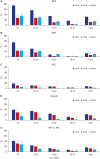Neonatal Outcomes of Very Low Birth Weight Infants in Korean Neonatal Network from 2013 to 2016
- PMID: 30718992
- PMCID: PMC6356024
- DOI: 10.3346/jkms.2019.34.e40
Neonatal Outcomes of Very Low Birth Weight Infants in Korean Neonatal Network from 2013 to 2016
Abstract
Background: This study was performed to determine survival and morbidity rates in very low birth weight infants (VLBWIs) in the Korean Neonatal Network (KNN), and to compare neonatal outcomes with those in other countries.
Methods: Data were collected for 8,269 VLBWIs with gestational age (GA) ≥ 22 weeks who were born between January 1, 2013 and December 31, 2016, and admitted to the neonatal intensive care units of the KNN.
Results: The survival rate of all VLBWIs and of infants with GA 22-23, 24-25, 26-27, 28-29, 30-32, and > 32 weeks were 86% (total), 33%, 65%, 84%, 94%, 97%, and 98%, respectively. The bronchopulmonary dysplasia (BPD) rates of all VLBWIs and of infants with GA 22-23, 24-25, 26-27, 28-29, 30-32, and > 32 weeks were 30% (total), 88%, 64%, 47%, 26%, 14%, and 5%, respectively. The intraventricular hemorrhage rates (≥ grade III) of all VLBWIs and of infants with GA 22-23, 24-25, 26-27, 28-29, 30-32, and > 32 weeks were 10% (total), 45%, 27%, 12%, 5%, 2%, and 1%, respectively. In an international comparison, the survival rate of VLBWIs with GA 24-27 weeks in KNN was lower, and the BPD rate of VLBWIs in the KNN was higher than that of the neonatal networks of other countries.
Conclusion: Despite overall improvements in neonatal outcomes, the survival and morbidity rates of more immature infants with GA 22-27 weeks need further improvement. Therefore, it would be necessary to develop more optimal treatment strategies and perform more active quality improvement to further improve neonatal outcomes of VLBWIs in Korea.
Keywords: Bronchopulmonary Dysplasia; Infant Mortality; Infant, Premature; Infant, Very Low Birth Weight.
Conflict of interest statement
Disclosure: The authors have no potential conflicts of interest to disclose.
Figures


Similar articles
-
The Prediction of Bronchopulmonary Dysplasia in Very Low Birth Weight Infants through Clinical Indicators within 1 Hour of Delivery.J Korean Med Sci. 2021 Mar 22;36(11):e81. doi: 10.3346/jkms.2021.36.e81. J Korean Med Sci. 2021. PMID: 33754511 Free PMC article.
-
Serial Short-Term Outcomes of Very-Low-Birth-Weight Infants in the Korean Neonatal Network From 2013 to 2020.J Korean Med Sci. 2022 Jul 25;37(29):e229. doi: 10.3346/jkms.2022.37.e229. J Korean Med Sci. 2022. PMID: 35880505 Free PMC article.
-
Neonatal outcome comparisons between preterm infants with or without early pulmonary hypertension following prolonged preterm premature rupture of membranes before 25 gestational weeks in Korean Neonatal Network.J Matern Fetal Neonatal Med. 2022 Apr;35(7):1286-1294. doi: 10.1080/14767058.2020.1749590. Epub 2020 May 6. J Matern Fetal Neonatal Med. 2022. PMID: 32228112
-
Improvement in the Survival Rates of Very Low Birth Weight Infants after the Establishment of the Korean Neonatal Network: Comparison between the 2000s and 2010s.J Korean Med Sci. 2017 Aug;32(8):1228-1234. doi: 10.3346/jkms.2017.32.8.1228. J Korean Med Sci. 2017. PMID: 28665056 Free PMC article. Review.
-
The Korean Neonatal Network: An Overview.J Korean Med Sci. 2015 Oct;30 Suppl 1(Suppl 1):S3-S11. doi: 10.3346/jkms.2015.30.S1.S3. Epub 2015 Oct 27. J Korean Med Sci. 2015. PMID: 26566355 Free PMC article. Review.
Cited by
-
Point prevalence, characteristics and treatment variations for preterm infants with bronchopulmonary dysplasia in China: a 'snapshot' study.BMJ Paediatr Open. 2024 Oct 4;8(1):e002878. doi: 10.1136/bmjpo-2024-002878. BMJ Paediatr Open. 2024. PMID: 39366748 Free PMC article.
-
Perinatal Outcomes According to Accessibility to Maternal-Fetal and Neonatal Intensive Care Units by Region in Korea.J Korean Med Sci. 2022 Mar 14;37(10):e77. doi: 10.3346/jkms.2022.37.e77. J Korean Med Sci. 2022. PMID: 35289138 Free PMC article.
-
Hospitalizations for viral respiratory infections in children under 2 years of age: epidemiology and in-hospital complications.BMC Pediatr. 2020 Jun 9;20(1):285. doi: 10.1186/s12887-020-02186-7. BMC Pediatr. 2020. PMID: 32517775 Free PMC article.
-
Medical Utilization and Costs in Preterm Infants in the First 6 Years of Life After Discharge From Neonatal Intensive Care Unit: A Nationwide Population-Based Study in Korea.J Korean Med Sci. 2022 Mar 28;37(12):e93. doi: 10.3346/jkms.2022.37.e93. J Korean Med Sci. 2022. PMID: 35347901 Free PMC article.
-
Bronchopulmonary dysplasia.Nat Rev Dis Primers. 2019 Nov 14;5(1):78. doi: 10.1038/s41572-019-0127-7. Nat Rev Dis Primers. 2019. PMID: 31727986 Free PMC article. Review.
References
-
- Liu L, Oza S, Hogan D, Perin J, Rudan I, Lawn JE, et al. Global, regional, and national causes of child mortality in 2000–13, with projections to inform post-2015 priorities: an updated systematic analysis. Lancet. 2015;385(9966):430–440. - PubMed
-
- Saigal S, Doyle LW. An overview of mortality and sequelae of preterm birth from infancy to adulthood. Lancet. 2008;371(9608):261–269. - PubMed
-
- Bartels DB, Wypij D, Wenzlaff P, Dammann O, Poets CF. Hospital volume and neonatal mortality among very low birth weight infants. Pediatrics. 2006;117(6):2206–2214. - PubMed
-
- Chung JH, Phibbs CS, Boscardin WJ, Kominski GF, Ortega AN, Needleman J. The effect of neonatal intensive care level and hospital volume on mortality of very low birth weight infants. Med Care. 2010;48(7):635–644. - PubMed
MeSH terms
LinkOut - more resources
Full Text Sources

